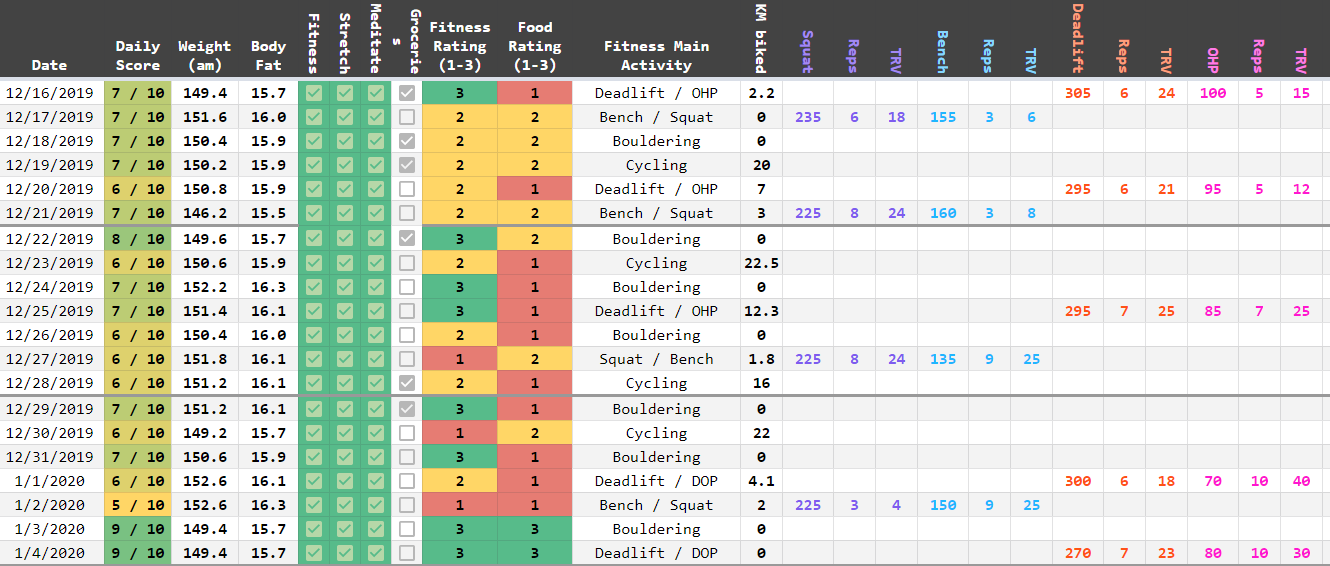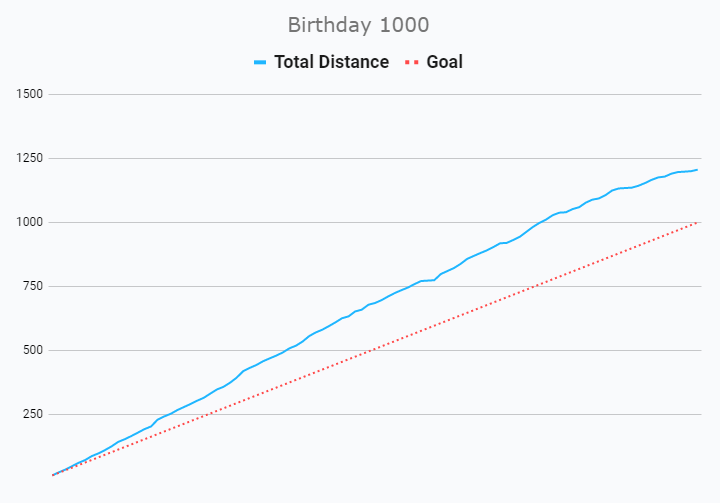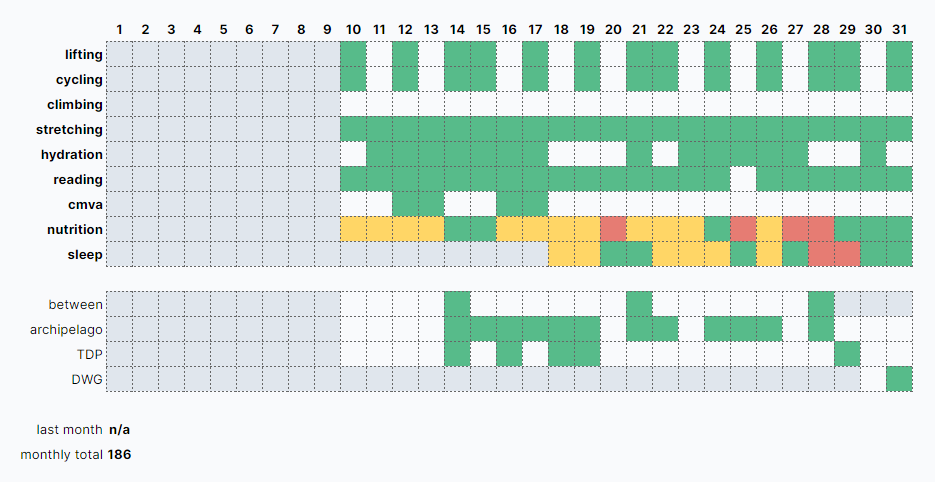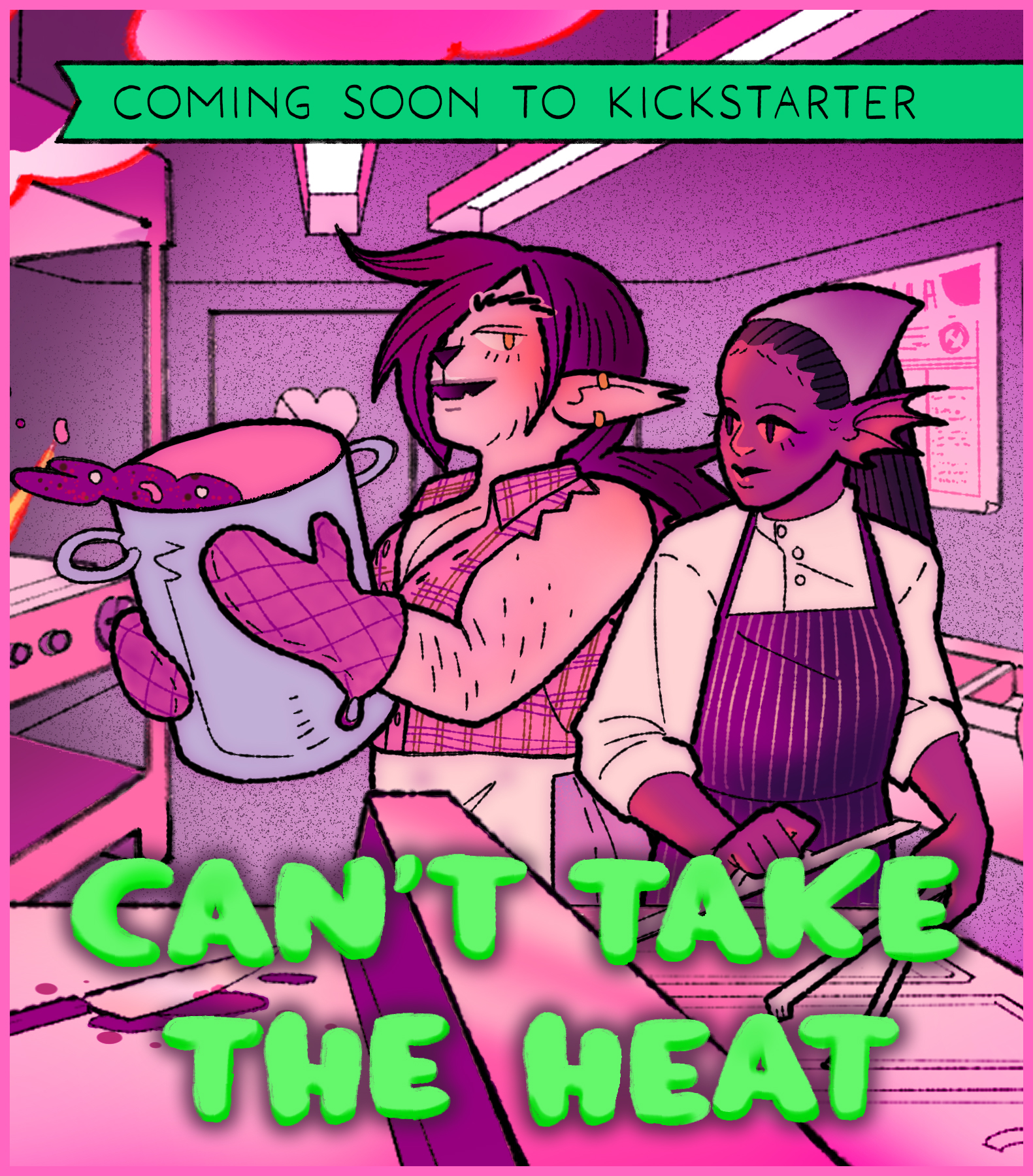2021 has been a difficult year. I’ve been “lucky” in that I work a day job that I still need to physically be at and it’s been relatively busy. That means that I haven’t been working from home, and for the most part, my “daily” routine hasn’t actually changed that much.
But the lack of physical activity over the pandemic has certainly affected me.
The Lead Up to 2021
The lack of some kind of structure of exercise didn’t seem like a big deal, and it took literally the first year of the pandemic for me to actually notice the detrimental effects on my mental health. I went from tracking things in my life in great detail to not tracking anything. For example, here’s what my spreadsheet looked like at the end of 2019 and start of 2020:

As you can see, there’s a lot going on here. Mainly, I was tracking some major things each day: doing some kind of fitness, stretching, meditating, and what nutritional rating I gave myself that day. I was also tracking my weight, body fat percentage, and lift amounts.
At this point in my tracking, I was up to 6+ months of some kind of fitness activity every single day. I was seeing some serious “don’t break the chain” momentum on days I just wanted to be lazy. At ~200 days of activity, my rest days were usually something like hopping on the bike and watching youtube videos.
When the pandemic hit and the gyms shut down, I couldn’t do any of that. No lifting, no bouldering, no cardio. I seriously considered investing in a power rack at home at the start of the year, but didn’t hop in right away, and prices proceeded to skyrocket.
The Start of 2021
At the start of 2021, I wasn’t tracking anything. For a lot of people, I think tracking so meticulously would be stressful, but for me it was the opposite. Keeping spreadsheets of what I do is my form of journaling, and my mental health was spiraling fast at this point.
I bought a cheap and junky stationary bike off of Amazon at this point. I could see that gyms wouldn’t be opening back up anytime soon, and knew I needed to do something. It arrived in February, and I set a goal for myself: hit 1000km by my birthday on May 11.
I managed to fall back into an easy groove with this, biking every day, averaging out to roughly 7.6km a day. I hit the goal and then some, ending up at 1206.6km on the end day:

But What About Games?
The first thing I ever published was the Wraithshroud for Slayers. I’m not really sure when I did this, but I know that it was a quick turnaround of about a week to write, test, and layout the entire thing. One thing that really helped was the gilarpgs discord server—everyone was incredibly supportive and encouraging.
Wraithshroud has 39 downloads, and I made $28 from it.
Not coincidentally, I published Smoke, Fuel, & Fire on May 11 (my birthday). I’m not sure the day I started working on the hack for Beak, Feather, & Bone, but I do have most of the numbers for how much time I put into it.
- I wrote the first draft without any sort of time tracking, but I’d estimate that it took me about 2 hours?
- I did a playtest with my home group that lasted 1 hour.
- The second draft after playtesting added another 5 hours and 25 minutes.
- Doing an editing pass for design and then for line edits took me 1 hour, but my good friend and excellent editor Ryan also took a pass at this, spending 1 hour and 30 minutes.
- Layout took me 10 hours and 21 minutes. This was my first actual layout, so a lot of this was learning.
- Creating assets for layout and landing pages, along with the itch.io and DriveThruRPG pages took 4 hours and 44 minutes.
- Designing a perchance.org page that could randomly generate factions took 1 hour and 15 minutes.
- Designing and running a promotional campaign took me 2 hours.
- This doesn’t include the amount of time it took Madeleine Ember to draw all the portraits, but I do know that she did a phenomenal job and I highly recommend her.
So, in total, we’re looking at roughly 27 hours and 45 minutes of just my time to create Smoke, Fuel, & Fire. As of this current moment in time, I’ve lost $64.07 to SF&F. This is okay to me, because of three reasons:
- I’m not in this to make fat stacks of cash.
- I put SF&F into the Palestinian Aid bundle on itch.
- I put SF&F into the Kentucky Tornado Relief bundle on DriveThruRPG.
The moment I put it into the first bundle was pretty much the last day I sold the game on itch, and the bundle was started roughly a month after I published the game. I’ve been getting a few sales every month from DriveThruRPG, and despite the bundle I think that’ll hold steady. The Kentucky bundle is less lucrative to purchasers than the Palestinian one, because DriveThruRPG cultivated the titles themselves and separated them into different tiers. Itch was community driven, and was just a huge bundle of games for a single price.
The end result is fine with me—I’m not going to pretend that SF&F being in the two bundles made anyone buy them, but if it helped even just a little bit, I’m happy about that. If I wanted to make money, I wouldn’t have put them in the bundles.
Overall, I really enjoyed the experience of taking an idea from inception all the way to hitting publish. On itch, SF&F has 2,358 downloads, which means that statistically, maybe 1 person other than me has played the game.
I put out a few pieces of tech for the tech jams: CORES and OAR. These were mostly written up in a day or so and published simultaneously here on mindstorm. My favorite thing about them was talking to other people who had read and enjoyed them. Specifically, I remember chatting with mv and how they dug CORES and talking with Adira on twitter a bit about OAR. I didn’t track any times for these—they were mostly just passion projects I was noodling on.
I missed an entry into the lifepath tech jam, and I’m sad about that, but the lifepath stuff has grown in size and scope. That’s a thing that’ll come in 2022. I’m working on a huge megapost about lifepaths, digging into what has come before, and what makes them interesting to me.
Game Jam Entries
I submitted Stationdark to the Light Strike Jam, using assets from Evlyn Moreau to create a space station map. I didn’t track the time spent on this, but I know that it was a surprisingly large amount. Probably 5-10 hours?
Stationdark has 115 downloads, and I’ve made $70 from it. I put 10,000 community copies up for it.
Next up, I made The Outcast for the Galactic 2e jam. I basically said “hey, what about Riddick, but in Star Wars?” I tracked the times on this one:
- First up, I spent 2 hours watching Pitch Black and taking notes. This is amusing, but my process was just writing down every single thing Riddick did in the movie.
- I spent 1 hour converting my notes to game text in the form of a Galactic 2e playbook.
- It took me 1 hour to draw the art, mostly by tracing over a picture of Riddick and coloring it in.
- The layout took 53 minutes.
- Putting together assets for the itch page took 5 minutes.
- Creating the landing page itself took 50 minutes.
So, in total, the playbook took me almost 6 hours.
The Outcast has 39 downloads, and I’ve made $4 from it. I put 200 community copies of it, I think.
I also joined the DURF jam! For that, I made the TURF faction rules. You want more analytical times, right?
- The first draft took 1 hour.
- Design editing on the draft took 25 minutes.
- Line editing took 10 minutes.
- Layout took 1 hour.
- The itch landing page and assets took 1 hour. I think most of this was searching for the specific piece of public domain art I used.
Totalling up to 3 hours and 35 minutes.
TURF has 166 downloads, and I’ve made $19 from it. I didn’t put any community copies up, making it “name your own price” with a suggestion of $2.
Lastly, I also wrote a threat for The Between, and submitted it as part of the threat writing contest held by The Gauntlet. That’s still an in progress project, that only needs layout to be released. For times:
- The first draft took 2 hours and 25 minutes.
- The second draft took 51 minutes.
- The third draft and editing took 1 hour.
So, for that threat without layout or art, we’re looking at 4 hours and 16 minutes.
I think Stationdark did so well because it’s specifically an adventure. I’ve noticed that it’s been added to a lot of collections that don’t have anything to do with the LIGHT RPG, so I think people might be collecting it to use for other science-fiction RPGs? I’d be very curious to see if anyone has actually ran it, though.
Also, a fun little tidbit: if we total up everything, I’ve technically made $56.93 from RPGs this year. That isn’t counting things like my blot.im subscription, affinity purchase, patreon subscriptions that I’ve used for art, etc. I’ve also spent quite a bit of money buying RPGs.
Back to Tracking
In August, I knew I was suffering quite a bit from free-wheeling it and not having any sort of structure to my days. So, I decided to create a new spreadsheet (I love spreadsheets a lot; see for example the Down We Go character sheet I made) and begin tracking again. I decided to switch up my method from the previous sheet, deciding instead to steal from Victoria Schwab.
Twitter, who will take up the habit tracker challenge with me as we head into a new month? The goal is to take things day by day. Each one, a clean slate. pic.twitter.com/KWWtxq7TVd
— Victoria/V.E. Schwab (@veschwab) February 29, 2020
So, I started on August 10. Here’s what August ended up looking like:

For clarity, everything but nutrition and sleep are binary things: it’s either nothing, or 1. If I did the activity, it gets a 1.
For hydration, I measure it if I drink at least 2L of water. For stretching, if I stretch for 10 minutes.
Nutrition and sleep are both things that I need to do everyday, so they get a sliding scale of 1-3: 1 being bad, 3 being best.
For sleep, the time I shut my eyes in bed is what determines the rating. For nutrition, it’s more of a ballpark of how much did I eat, what was the quality of what I ate, and how much of it was just junk food.
I’m not going to post each month as a graphic, and instead we’ll just look at the trends for 2021, with the caveat being that they’re actually trends from August - December of 2021. First up, let’s look at my daily habits:
| DAILY | TOTAL | AVERAGE |
|---|---|---|
| lifting | 56 | 39% |
| cardio | 63 | 44% |
| climbing | 4 | 3% |
| stretching | 97 | 68% |
| hydration | 98 | 69% |
| reading | 130 | 91% |
| nutrition | 244 | 60% |
| sleep | 208 | 59% |
The raw data of the totals probably isn’t super interesting, but the averages are. Climbing is low because it took me a long time to get back to it, but now that I have, I feel like it’ll shoot up in 2022. I enjoy climbing more than lifting these days, and I probably am never going to be as strong as I was when I competed in powerlifting. That’s okay.
Daily reading is one of the things I have the least friction with—I love reading books, and it’s part of my night time ritual, but also my break time ritual at work. The chance of not reading is pretty low: 9%, I guess.
I need to work on the rest for 2022. Stretching started off very strong, but I started slacking in November and it’s been tough to get back. Hydration is something I struggle with on the weekends only. When I’m at work, I’ll drink 2L easily before 2:30 pm, and then probably another litre if I’m working out. On the weekends, I’ll be lucky to even finish 1L of water. I really need to work on this, and find some way to create a habit where I’m getting more water on the weekends.
Now, on to the RPG stuff. These are binary as well—if I worked on it that day, it gets a 1. Let’s look through the totals, sorting from highest the lowest.
| RPG STUFF | TOTAL | AVERAGE |
|---|---|---|
| archipelago | 20 | 14% |
| mindstorm | 17 | 12% |
| Bones | 12 | 8% |
| KJ | 11 | 8% |
| TDP | 10 | 7% |
| DWG | 9 | 6% |
| MITR | 9 | 6% |
| OLR | 8 | 6% |
| TURF | 5 | 3% |
| ATD | 4 | 3% |
| Hollovine | 4 | 3% |
| between | 3 | 2% |
| RPG | 3 | 2% |
| Mountain | 3 | 2% |
| OTDG | 3 | 2% |
| Metal Sky | 1 | 1% |
| Gravediggers | 1 | 1% |
| Slayers | 1 | 1% |
| BK | 1 | 1% |
| Total RPG | 124 | 87% |
First off, some clarification. 87% for a total does not mean that I worked on RPG related stuff on 87% of the days I tracked. For a lot of days, I would work on multiple projects, and then other days I would do nothing. So that’s a bit inaccurate.
Archipelago is one of my biggest projects, a game I’m working on collaboratively with Ryan. Together, we have 8 hours in on the first draft, and probably 3-6 hours that I didn’t track that we did in voice calls.
Mindstorm (which is this, you’re reading it now) was put on the backburner earlier this year, but I dusted it off and have been enjoying it a lot once I recalibrated what my intentions are with it—none! It’s pretty much here to let me type endlessly into the void.
Bones of Contention is the review blog that I recently joined. I’ve only published the one review so far, and I guess I spent ~12 days working on that? It certainly wasn’t consecutive. I’m eager to write more of these in 2022. The pressure of being amongst other high quality reviewers probably added to the overall amount of days I’ve worked on this.
The rest of these are sort of esoteric projects that I’m noodling back and forth on. Some of them are 90% written projects, like MITR (Monsters in the Revolution). Others have been sidetracks and distractions that I’ve been following to their natural conclusions. Oftentimes, that means the backburner.
2022 Projects
It’s quite hard for me to talk about upcoming projects, since I’m always shifting what I’m working on, and never quite know what’s going to make it all the way to the finished step. Still, I think it’s okay to talk about a few.
Hollovine is my current baby and the big project. You won’t see it much in the tracking above, but the game currently has 13 hours and 20 minutes of total work put into it, and I’m still moving forward on it. It’s a game contained entirely in a single city, hyper-focused on revenge. Through a detailed lifepath system, all the PCs come out with a singular nemesis, a character that has taken everything from them. Banding together, they’re in it for revenge—whatever the cost. It’s one part strange fantasy, one part Oceans Eleven / Italian Job. There’s a complex faction engine running in the game, as you can’t just go straight for the nemesis—you need to work your way through their lieutenants first. The system is my own creation, but there’s familiar parts in it: the mystery system from The Between / Brindlewood Bay, and a resolution mechanic similar (but not the same) to Ironsworn.
Archipelago is currently on the backburner, but I’m hoping we can get back to it at some point. It’ll run on the same system as Hollovine, with a few modifications. It’s a ship-faring game in a hostile world ravaged by powerful and frequent hurricanes. The players take on the officer positions, and their job is to travel around, seeking a magical fire to bring back to the villages in the archipelago—which they use as fuel to shield themselves from the devastating hurricanes. I believe the method of doing ship vs. ship combat I’ve cooked up is pretty interesting.
Monsters of the Revolution is a Down We Go hack, almost all the way there. It’s set in a world close enough to ours, but in a setting where werewolves, vampires, and all manner of supernaturals exist in plain sight, as members of the lowest and most oppressed class. The game is a revolution, from the first spark to burning it all down. I have a lot of the text written, including character creation (you can make almost every kind of supernatural creature you can think of) and now need to work on the mission generator tables. I’m trying to emulate Kevin Crawford tables, so essentially these detailed things that can help a GM prep a game session in a short time. I need to do some thinking about this one as well, because I don’t want to make a game that is implying a connection with the current oppressed communities in society and… monsters. In the game, I want the general theme to be that, while the players are literal monsters, the real monsters are those at the top.
Gravediggers is a project I really want to dive into in 2022. It’s not a game, but rather serial fiction I want to write based on an Ironsworn: Starforged solo game. I’m not going to talk much about it, because I think the less you know about a piece of fiction before you consume it the better, but I’m very excited to start writing prose and having 1 or 2 people read it.
The Operatives is a game I wrote after listening to the GDC talk about Hitman and social spaces. It’s pretty simple. Each type of social space has acceptable actions you can perform in it, where you don’t naturally draw attention if you do them. When you perform an action outside of its acceptable space, you’re rolling your action dice and the GM is rolling fallout dice—bad stuff that happens because you’re being weird in a place you shouldn’t be. The amount of fallout dice increases depending on how many “steps” along the chart you are from the acceptable space. The game mechanics are very simple and 95% of the way there. What’s holding this back currently is that I can’t release this game without at least 3 solid adventures to go along with it. Since so much of this game depends on the understanding of the locations, I don’t think winging it would be a good way to play, hence the requirement for bundled adventures. Ideally, I want all three of them to be in different settings: one with modern day spies, one in a thief/dishonored type setting, and one in the future on a orbital space station. I have not written a single word for these adventures.
2022 Processes
I don’t really want to set specific “goals” because I don’t find them very useful, but I do think it’s neat to try and work new habits and processes into my life, so let’s look at that.
I’m also currently doing the Year Compass and it’s hilarious to me how much I’ve just… forgotten. I have a strange memory, where I retain an astounding amount of information about things, but when it comes to time, my mind struggles with it as a frame of reference. If someone asks how old I am, I need to do the math and figure it out. If someone were to ask me what I was doing in 2010, I would numbly think back and remember past events, but those events don’t have a connection to time.
So, one thing I want to do is a few check-ins throughout the year. Something like this post, but maybe on a monthly scale, instead of one major one at the end of the year. My plan for this is to create a 2022 retrospective draft and then once a month I can go in and fill it out. That way, I’m closer to the events and hopefully can remember them better. I guess it’ll be a bit like a journal? The urge to make it a spreadsheet is powerful.
I’m going to take some time and think about what that looks like structurally. I probably don’t want it to just be a list of things that I did or had happen to me, but more along the lines with expectations, check-ins, and hopes for the next month. Maybe major check-ins, similar to the Year Compass, every quarter?
I also want to start tracking new experiences. Every time I do something I’ve never done before, I’m going to write it down.
welcome to the new year
If you made it this far, you’re probably me proofreading this document. If you’re someone not me, thank you so much. Hopefully this was, at the least, a bit entertaining. If you feel like it, reach out with a comment! What was your year like? What are you hoping for next year? Is there anything I could help you with?
edit: if you were the kind person that left the long and thoughtful comment, I’m not sure why the comment system ate it or deleted it! It wasn’t me!

Did you enjoy this post? Consider signing up to the mindstorm, my semi-regular newsletter!
